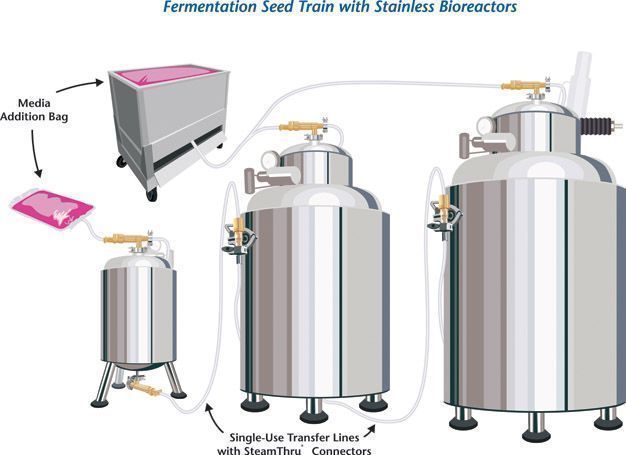Single-Use Transfer Lines: Seed Trains
Single-use transfer lines can be used in conjunction with existing processing equipment to reduce validation and maintenance costs required with stainless steel piping and valves. For example, a 10,000 L production suite with stainless steel bioreactors can integrate single-use technology for cell culture media storage and key transfer lines. Single-use media storage systems arrive at the bioprocess facility sterilized by gamma irradiation and often fitted with integrated filters, sampling systems and connectors. Using a single-use SIP connector allows operators to make sterile connections between these presterilized single-use systems and stainless steel bioreactors for aseptic transfer of media.
Similarly, operators can use single-use transfer lines to transfer inoculum between bioreactors, using either a peristaltic pump or head-space pressure. Such transfer lines can reduce the number of reusable valves required for transfer and can eliminate problem areas for CIP and SIP validation. Terminating each presterilized transfer line with a single-use SIP connector provides sterility assurance equal to that of traditional fixed piping at lower capital costs.

This production suite relies on stainless steel bioreactors but integrates single-use technology for cell culture media storage and key transfer lines.
Single-use systems are connected to a cell culture media storage bag — either by aseptic welding or with an AseptiQuik Connector — using flexible tubing. Likewise, flexible tubing with AseptiQuik connections is used for transfer lines between each reactor in the process. For production volumes over 1,000 L, a single-use bioreactor must ultimately seed one or more stainless steel bioreactors. Steam-Thru Connections incorporated into the single-use bioreactor design can link the single-use and stainless steel section of a seed train.
For added safety, an HFC39 quick-disconnect coupling which has been validated as an aseptic disconnect can be used to remove single-use bags and tubing after the media transfer is complete.